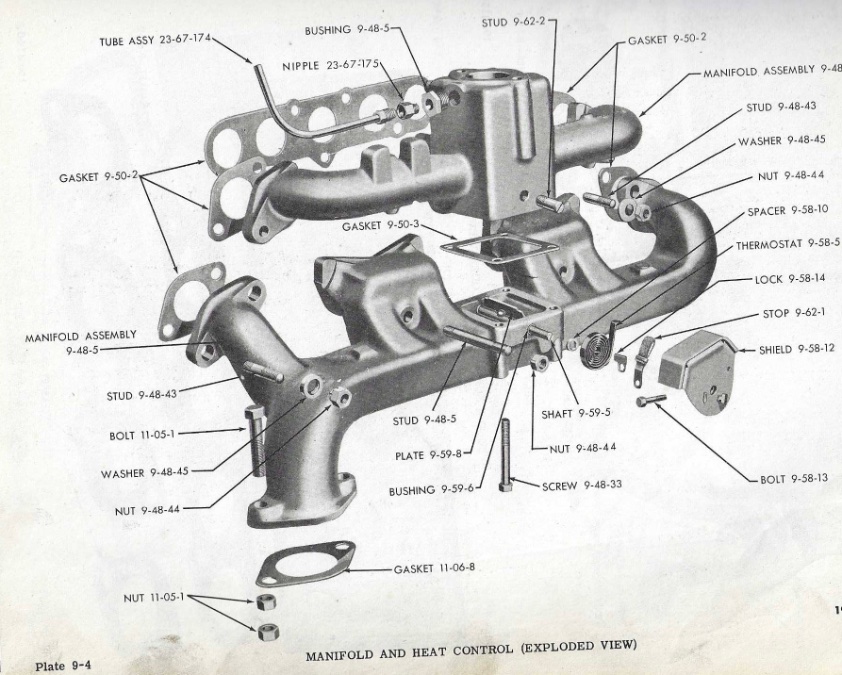-
Posts
1,860 -
Joined
-
Last visited
-
Days Won
10
Everything posted by MarcDeSoto
-

Big holes drilled in my brake shoes...why?
MarcDeSoto replied to Art Bailey's topic in P15-D24 Forum
Look like the two rivets are below the holes. I have never seen those holes. Could it be for heat dissapation? -

1946 Chrysler starter questions, more help needed please!!
MarcDeSoto replied to harmony's topic in P15-D24 Forum
Of those three starters you pictured, you should have the Positive Drive (Solenoid), not the Bendix. Starters are very important parts. I would suggest getting a good one that is original and taking it to an Electric shop with experience with 6 volt starters. That's what I did, but I'm still waiting for it to be finished as they had to send my solenoid switch to specialist, since they didn't have the right parts for the switch. -

M6 transmission clutch free play specification
MarcDeSoto replied to Graefen's topic in P15-D24 Forum
My DeSoto 46-50 manual says the free play at the pedal should be 1". That's for all MoPar cars standard trans. or semi-automatic. To adjust the clutch pedal free play, turn the release fork rod adjusting nut until the pedal has 1 inch free play. The clutch pedal location is controlled by a set screw and lock nut. It controls the clearance between the toe board and the pedal. -
take the sending unit off and look at the inside with a good flashlight. Most tanks need to be treated for rust. I had my radiator shop do it. They will have to cut a 6 X 6" square off the top of that tank in order to remove the rusted all to hell oilite fuel filter that won't work now. Then they will treat the rust and paint the inside with an ethanol resistant rust resistant red paint. Then they will braze the metal square back on and paint the tank.
-
I assume the gas in your tank is over 40 or 50 years old. Don't reuse it or you could mess up whatever you put it in. When I drained my 48 DeSoto tank, the gas smelled rotten. You just drain into the same sealed container you drain your oil into. Put the cap on and take it to your local Auto Zone. Tell them you have some old gasoline, and they will drain it into the right container. I took old gasoline to an auto store once, but that was 30 years ago. Sniper is right that they won't take it now!
-

Different way to do static tappet adjustment on flathead six.
MarcDeSoto replied to MarcDeSoto's topic in P15-D24 Forum
I did something similar. I put a yellow dot on all the exhaust valves permenantly, just so I'm not confused when I'm setting the tappets. -

1946 Chrysler starter questions, more help needed please!!
MarcDeSoto replied to harmony's topic in P15-D24 Forum
Does that starter actually work? It looks like it needs some work with all that rust on it. The plunger needs to a rubber boot on it to shield it from dirt and I would put some lithium grease on it. I'd put a picture of my starter here, but it's still in the shop. They had to send the solenoid switch back east to a specialist because the points were sticking causing the dreaded starter run on after the engine starts. -
Could it be from a 60s slant six off of a Dodge Dart?
-
Over on the AACA Technical forum, there is an interesting post by Phantom. He says you can do a static tappet adjustment with the crankshaft in just two positions, rotor at 7:00 and at 1:30. So at 7:00, TDC for no. 1 cylinder you can adjust these tappets: 1 cyl. Ex and In 3 cyl. Ex 4 cyl. In 5 cyl. Ex and In With the TCD at firing position for cyl. no. 6, and the rotor at 1:30 you can adjust these tappets: 2 cyl. Ex and In 3 cyl. In 4. cyl. Ex 6 cyl. Ex and In Interesting to know if that is correct.
-

Manifold heat control package for 48 DeSoto
MarcDeSoto replied to MarcDeSoto's topic in P15-D24 Forum
I will bet that the tough material on the stop is pure asbestos! -

Manifold heat control package for 48 DeSoto
MarcDeSoto replied to MarcDeSoto's topic in P15-D24 Forum
I bought the AB spring also, but you can bet I'm going to use the NOS MoPar one instead. MoPar made in Detroit beats China junk every time! Does anyone know what the stop does? Keith show the crimp on the spring going on the shaft, but I wonder if it is supposed to go on the stop? I saw the square nut on Keith's valve, so I bought a 10-32 nut, but it's a hex head. I guess it doesn't matter. I think the lock goes on the bolt like the stop does since it has the hole. It must be there to hold the cover on? -

Manifold heat control package for 48 DeSoto
MarcDeSoto replied to MarcDeSoto's topic in P15-D24 Forum
Keith's video talks about the basics of how the thermostatic spring works. He doesn't mention the parts I'm talking about. And it didn't look like he had the stop, or the lock, or those bushings. Since the blow up doesn't show the bushings, I'm assuming they are for something else, like re-bushing the rod bore in the ex. manifold. Either his manifold was missing them, or a 38 car didn't have them. -
I'm missing some parts for my manifold heat control valve, like the cover and some other parts. I was lucky and found an NOS Manifold Heat Control Package part # 1316 267. I also found a manifold blow up from my P-15 Parts List. But I still don't know how the parts fit together. Does the small bolt that goes through the cover require a nut? I assume so, but no nut was in the box and I don't see a nut in the blow up or the Parts List. How is the stop put on and what way does it point? Where do you put the lock? What are those four pieces that look like bushings, two bushings and two rings?
-

1942 Chrysler Vacamatic Transmission - carb wiring
MarcDeSoto replied to Strictlyballroom's topic in P15-D24 Forum
You asked for any help, so here goes. I have a wiring diagram for an S-11 DeSoto 46-48. My carburetor looks the same as yours. Your trans. looks different because of the vacuum controls, whereas mine has hydraulic controls. I assume you have a transmission relay box on your left inner fender. The carburetor anti-stall terminal on the carb. goes to the SOL terminal on the relay as well as the Solenoid on the trans. The kick down switch wire on the carb. goes to the TH on the relay, as well as to the Governor on the trans. The interrupter switch wire goes to the INT terminal on the relay. I have a 42 DeSoto Parts List and it lists a wire that goes from the Solenoid to the Governor on the trans. So the answer to your last question is BOTH. -
Love the sound of that flathead!
-
All I do is attach an alligator lead to the probe, and now it has alligator leads on both sides.
-

Is this a good product for Fluid Drive and transmission?
MarcDeSoto replied to MarcDeSoto's topic in P15-D24 Forum
Thanks. all of us with FDs would like to know the shop if it works out. I hope he's experienced and has the right tools. -
I just used carb cleaner on my carburetor and blew out the jets and holes with compressed air. I just check my accelerator pump and I now have a strong stream! Just waiting to get my starter back so I can continue tuning up the engine.
-
Oh, the plugs on the carb. I get it. I just recently rebuilt my 48 DeSoto Carter B&B carb. I removed the plugs to clean out everything.
-

Is this a good product for Fluid Drive and transmission?
MarcDeSoto replied to MarcDeSoto's topic in P15-D24 Forum
I've heard that job is quite expensive. Can you tell us about it costs to do that in case mine ever leaks? I'm thinking of using my junk FD from a 48 Dodge I used to have to learn on. I have the Miller FD overhaul tool kit. -
Removed the lead? Do you mean removed the leaded gas?
-
When people ask about what fluid to put in the Fluid Drive and the transmission, I say to put Mobil Light Circulating OIl iso 32 and 10 W non detergent in the tranmission. But on the AACA Forum, another guy recommends a tractor oil like this for both. Is this product better for the semi auto trans. and the FD? https://www.amazon.com/Mobil-DTE-24-Hydraulic-Oil/dp/B06XCBZRX2/?_encoding=UTF8&pd_rd_w=shbpx&content-id=amzn1.sym.03bef33a-a357-4fe3-9505-7fd4d6236957&pf_rd_p=03bef33a-a357-4fe3-9505-7fd4d6236957&pf_rd_r=9H20HARCS8HA8A362J8N&pd_rd_wg=jSnHt&pd_rd_r=befc557f-96ef-4fec-a420-37a8028404e9&ref_=pd_gw_ci_mcx_mr_hp_d
-

Fixing inside bumper rust with POR 15 on 48 DeSoto
MarcDeSoto replied to MarcDeSoto's topic in P15-D24 Forum
That's a salesman's Data Book. They were property of the dealership and not given out to customers, so they are rare. I have one for my 48 DeSoto. It shows all the features of the car in case a customer asks about the transmission or the horsepower or the brakes, or how wide the seats are, the Data Book would have it. My DeSoto Data Book also shows comparisons between DeSoto vs. Pontiac, Buick, Mercury, etc. -

Fixing inside bumper rust with POR 15 on 48 DeSoto
MarcDeSoto replied to MarcDeSoto's topic in P15-D24 Forum
Well, Chryslers are well known for three front bumper brackets, I think from 1941 to 1948. No one can get anything past the great Marcus the Magnificent! -

Fixing inside bumper rust with POR 15 on 48 DeSoto
MarcDeSoto replied to MarcDeSoto's topic in P15-D24 Forum
That's an ingenious solution! Bumper looks great, but are you missing the middle bumper bracket?




